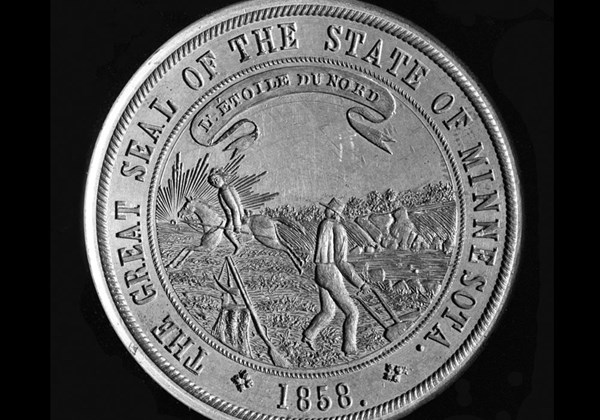Historic State Seal

This symbol was adopted as the state seal in 1858 and retired on May 11, 2024.
When Minnesota became a state on May 11, 1858, it did not have an official state seal—despite a constitutional requirement to have one.
Minnesota’s first Secretary of State, Francis Baasen, wrote to Governor Henry Sibley requesting direction on the matter. Sibley authorized Bassen to use Minnesota’s previous territorial government’s seal. In the meantime, Sibley began making design changes and correcting errors discovered when the seal was cast in metal. He replaced a misspelled Latin motto, “Quo sursum velo videre,” which means “I want to see what lies beyond” with a French motto, “L’Étoile du Nord,” meaning “the Star of the North.” He also reversed the picture on the seal to depict the sun setting in the west instead of rising in the east. Around the seal design he placed the words, “The Great Seal of the State of Minnesota 1858.” In 1861, the Legislature adopted the new design, making it the official state seal.
In 1983, the Legislature altered the seal in an attempt to spell out specific design details more clearly in hopes of avoiding the wide variations that occurred in past artistic interpretations.
The Great Seal of the State of Minnesota is rich in symbolism. The sun, visible on the western horizon, signifies the flat plains covering much of the state. The cultivated ground and plow symbolize the importance of agriculture. The Mississippi River and St. Anthony Falls are depicted to note the importance of Minnesota’s natural resources for trade and commerce. The three pine trees represent the state tree, the Red or Norway pine, and the three great pine regions of the state including the St. Croix, Mississippi, and Lake Superior. The tree stump symbolizes the importance of Minnesota’s timber industry. The American Indian on horseback represents the great American Indian heritage of the state while the horse, spear, axe, rifle, and plow represent important tools that were used for hunting and labor.